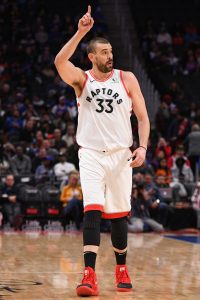Hoops Rumors is previewing the 2020 offseason for all 30 NBA teams. We’re looking at the key questions facing each club, as well as the roster decisions they’ll have to make this fall. Today, we’re focusing on the Denver Nuggets.
Salary Cap Outlook
Taking into account eight players and their first-round draft pick, the Nuggets are currently on the hook for just over $100MM in commitments for 2020/21. That’s won’t put them in position to create any cap room, but it should allow them to re-sign some combination of Jerami Grant, Paul Millsap, Torrey Craig, and Mason Plumlee without going into tax territory.
The full mid-level exception ($9.26MM) and bi-annual exception ($3.26MM) should be in play for Denver, though there’s a chance the team will be limited to the taxpayer MLE ($5.72MM) if re-signing its own free agents gets expensive.
Our full salary cap preview for the Nuggets can be found right here.
Roster Decisions To Watch
Options:
 Jerami Grant, player option: $9,346,153
Jerami Grant, player option: $9,346,153
- Note: Grant will reportedly decline his option.
Non-Guaranteed Contracts:
- PJ Dozier ($1,762,796)
- Note: Partially guaranteed for $1.2MM.
- Monte Morris ($1,663,861)
- Keita Bates-Diop ($1,663,861)
Two-Way Contracts:
- Bol Bol (expires in 2021)
Free Agents:
- Paul Millsap (Bird)
- Mason Plumlee (Bird)
- Noah Vonleh (Non-Bird)
- Troy Daniels (Non-Bird)
- Torrey Craig (RFA; Bird)
- Tyler Cook (N/A)
- Note: Cook won’t have any form of Bird rights because he was signed as a substitute player.
2020 Draft Assets
First Round:
- No. 22 overall pick
Second Round:
- None
The Nuggets traded away both of their own picks in the 2020 draft. The first-rounder (No. 25) went to Oklahoma City in 2019’s Jerami Grant swap, while the second-rounder (No. 55) was part of a 2018 salary-dump deal that sent Kenneth Faried and Darrell Arthur to Brooklyn.
Denver did acquire an extra first-round pick to replace its own though, landing the Rockets’ pick (No. 22) in February’s four-team trade that sent Malik Beasley and Juan Hernangomez to Minnesota.
Three Key Offseason Questions
1. Will the Nuggets re-sign Jerami Grant?
Grant’s time in Denver got off to a shaky start in 2019/20. In their 42 games through January 19, the Nuggets had a -5.6 net rating when Grant was on the court and a +14.0 rating when he sat, one of the most significant discrepancies in the league.
That gap wasn’t all Grant’s fault, of course — he was still scoring in the double digits and knocking down his threes at a 36.4% clip during that time. But he was inconsistent on the defensive end, as it took some time for Denver to figure out how to make the most of his versatility and pair him with the right teammates.
After January 19, the Nuggets’ net rating for the rest of the regular season was five points better when Grant was on the court. And he was a key contributor in the postseason, starting 16 of Denver’s 19 playoff games and averaging 34.4 minutes per contest against the Jazz, Clippers, and Lakers. The Nuggets couldn’t do much in the Western Finals against the Lakers, but Grant was one of the few bright spots — he averaged 21.0 PPG on 47.6% in the team’s final three games of the season.
While Grant’s first year in Denver wasn’t perfect, he had become one of the team’s most important role players by season’s end and showed why the club surrendered a first-round pick for him last July. The Nuggets didn’t give up that first-rounder expecting Grant to be a one-year rental, so there’s no reason to think the organization won’t make every effort to re-sign him this fall.
Grant will be an unrestricted free agent, which means he’s free to sign elsewhere if he doesn’t want to return to Denver. But unless the Nuggets are willing to work out a sign-and-trade deal, the 26-year-old’s best opportunity to play for a contender in 2020/21 will probably be with his current club. Using his Bird rights, the Nuggets can offer Grant a starting salary well above the mid-level exception, outbidding most rival suitors.
That doesn’t mean Grant won’t have other options, especially if he’s willing to join a lottery team. The Pistons and Hawks are expected to have interest and have the cap room necessary to put pressure on Denver. The Suns and Heat have also been linked to Grant, though both of those clubs would need to jettison some of their own free agents to create enough cap space for a run at the Nuggets forward, which could complicate matters. The Mavericks are also said to have interest in Grant, but they project to be over the cap, which could compromise their ability to put a competitive offer on the table.
It may ultimately come down to price. Bobby Marks of ESPN projects a $12-14MM starting salary for Grant, while Mike Singer of The Denver Post has estimated the forward could command upwards of $14-16MM per year. An offer in the four-year, $60MM range seems about right for Grant and the Nuggets. If another team is willing to significantly outbid that offer, Denver will face a difficult decision.
2. Will any of the Nuggets’ other notable free agents be back?
Besides Grant, a handful of other Nuggets will be free agents, including Paul Millsap (unrestricted), Mason Plumlee (unrestricted), and Torrey Craig (restricted).
None of those players are indispensable, but president of basketball operations Tim Connelly and general manager Calvin Booth have spoken about wanting to retain as many of their own free agents as possible. It’ll be interesting to see how committed they are to following through on that vow, especially when it comes to Millsap.
 At age 35, Millsap is past his prime years and isn’t going to make any more All-Star teams, like he did in Atlanta for four consecutive years from 2014-17. But his value shouldn’t be understated. The big man has had a major impact on Denver’s defense since his arrival in 2017, fitting in perfectly on a team led by a pair of offense-first stars in Nikola Jokic and Jamal Murray. His toughness and defensive savvy have take some pressure off Jokic, and he’d be missed if the Nuggets let him walk.
At age 35, Millsap is past his prime years and isn’t going to make any more All-Star teams, like he did in Atlanta for four consecutive years from 2014-17. But his value shouldn’t be understated. The big man has had a major impact on Denver’s defense since his arrival in 2017, fitting in perfectly on a team led by a pair of offense-first stars in Nikola Jokic and Jamal Murray. His toughness and defensive savvy have take some pressure off Jokic, and he’d be missed if the Nuggets let him walk.
Connelly has said he’d “love to see” Millsap spend the rest of his career in Denver and I expect the team to attempt to re-sign him. But it wouldn’t be a surprise to see a rival suitor try to lure Millsap away with an oversized one-year offer in the hopes of shoring up its own frontcourt defense.
If the Nuggets are willing to match an offer in the $9-10MM range for Millsap while also re-signing Grant, it would push team salary close to the tax and would likely prevent Denver from using its full mid-level exception. Connelly, Booth, and company may have to decide whether bringing back both its top free agent forwards is more important than retaining the flexibility to use that MLE on an outside target.
Plumlee and Craig are less likely to incite a bidding war, but they each have some value. Plumlee has been a solid backup and won’t be as expensive this time around as he was when Denver signed him to a three-year, $41MM deal in 2017. Assuming the Nuggets can get him at half of his previous $14MM salary (or less), he could be back.
As for Craig, he was one of the team’s top perimeter defenders, but his offensive contributions were limited. With the Nuggets likely to explore the free agent and trade markets for a wing who has more two-way value, Craig could become expendable unless he’s willing to take a minimum deal or something very close to it.
3. Do the Nuggets have the pieces to swing a trade for a third impact player?
Jokic has emerged as a perennial candidate for the All-NBA First Team, and Murray – despite some frustrating ups and down during the regular season – showed during the postseason at Walt Disney World that he deserves to be considered Denver’s second star. He averaged 26.5 PPG and 6.6 APG on .505/.453/.897 shooting during the Nuggets’ 19 playoff games.
With a frontcourt and backcourt star locked up the foreseeable future, the Nuggets could badly use a wing capable of making an impact on both ends of the court. Will Barton and Gary Harris are good players, but they aren’t stars. And while Michael Porter Jr. has star potential on offense, he’s a liability on the other end of the floor at this point in his career and is unlikely to ever develop into a lockdown defender, even if he makes some strides in that area.
The Nuggets don’t have the cap room to make a splash in free agency this fall and there aren’t any logical targets on the open market anyway. So the trade market may be the team’s best bet to try to find a wing of that caliber.
One potential trade candidate, who has been linked to Denver in the past, is Pelicans guard Jrue Holiday. A defensive dynamo, Holiday is entering a potential contract year and the Nuggets are expected to be among his most aggressive suitors if New Orleans makes him available.
What would an offer for Holiday realistically look like? Obviously Denver won’t include Jokic or Murray, and Porter is said to be virtually untouchable too. Harris is the most logical salary-matching piece — from there it would just be a matter of how many sweeteners the Nuggets are willing to offer. Monte Morris and/or Bol Bol could interest the Pelicans. Denver also has all its first-round picks available beyond this season and could put more than one – including this year’s No. 22 selection – in an offer.
It’s not clear if such a proposal would appeal to the Pelicans more than something the Nets or another suitor could put together. If New Orleans demands Porter, would the Nuggets be willing to change their stance on the 22-year-old? I’m skeptical. As good as Holiday is, he’s made one All-Star team in his career (in 2013), is on the wrong side of 30, and could reach free agency in a year. If Denver is convinced to give up Porter, I think it’d probably have to be for a player a tier above Holiday.
It’s not clear if that sort of player will be available this fall though. Victor Oladipo is another target who might make sense for the Nuggets, but his health makes him a risk — I’m not sure Denver would want to offer much more than Harris and a first-round pick for the Pacers guard.
The Nuggets made it to the Western Finals in 2020 after forcing a seventh game in the Western Semifinals in 2019. They’re close to breaking through and acquiring an impact wing could be the move that helps put them over the top. We’ll have to wait see how aggressively Connelly and the front office pursue that sort of player this offseason.
Information from Basketball Insiders and ESPN was used in the creation of this post. Photos courtesy of USA Today Sports Images.
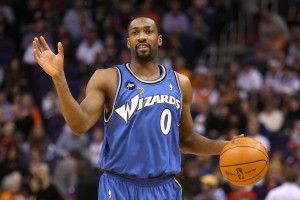 While Arenas isn’t specifically named in the CBA, the rule colloquially known as the Arenas provision stems from his own restricted free agency in 2003. At the time, the Warriors only had
While Arenas isn’t specifically named in the CBA, the rule colloquially known as the Arenas provision stems from his own restricted free agency in 2003. At the time, the Warriors only had 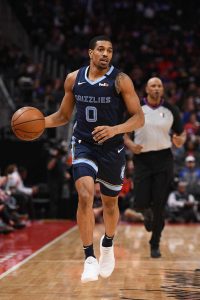
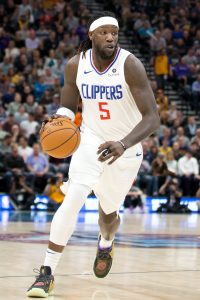
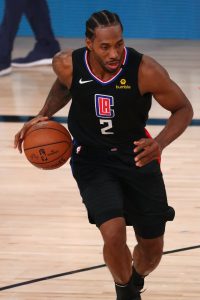 It was a major coup for a long-downtrodden franchise last July when Leonard chose to sign with the Clippers and essentially brought George along with him in a trade from the Thunder.
It was a major coup for a long-downtrodden franchise last July when Leonard chose to sign with the Clippers and essentially brought George along with him in a trade from the Thunder.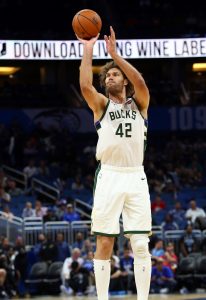
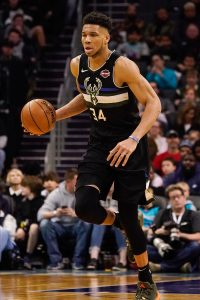 Antetokounmpo has
Antetokounmpo has 
 Still, it’s not as if Houston is in a downward spiral. After all, the club lost to the eventual champions this year and can bring back essentially the same core next season. The Rockets’ most important players –
Still, it’s not as if Houston is in a downward spiral. After all, the club lost to the eventual champions this year and can bring back essentially the same core next season. The Rockets’ most important players – 
